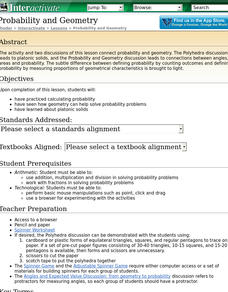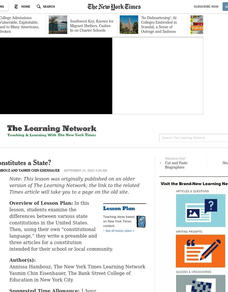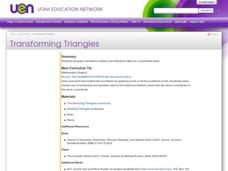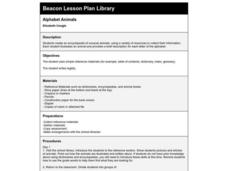Curated OER
Cruel Schools
Students survey the climate of their school. In this personal health lesson, students discuss bullying and violence in schools. Students then complete a school climate survey, compile the results, and interpret them. Students write data...
Curated OER
Mathematics Alive: Environment and Design of Human Habitats
Third graders explore the structural composition of buildings and houses. In this math lesson, 3rd graders explain how architecture is related to mathematics. They create a blueprint of a structure with at least three different spaces.
Curated OER
What Do Halloween Costumes Say?
Students analyze Halloween costumes they find in magazines to categorize their findings. In this holiday lesson, students discuss their findings about the costumes based on four different elements.
Curated OER
Probability and Geometry
Students practice calculating probability, see how geometry can help solve probability problems and explore platonic solids.
Curated OER
Oh, Let the Rain Fall Down
Fifth graders explain the three phases of the water cycle in a narraive paragraph where they describe the journey of a single raindrop. They are introduced to five science vocabulary words and personfication.
Curated OER
Storytelling in the Oral Tradition
Seventh graders research Greek mythological characters. They write about problems faced by middle school-aged children and how the character would handle them. Students also create story boards to accompany their oral narratives.
Curated OER
Donde en el mundo estas?
Learners give & follow directions given in Spanish, using oral, written and graphics. They use maps, globes, atlases, and remote sensing, GIS, and GPS to acquire and process information about places.
Oklahoma State Department of Education
Sandwich Feast
Creative! Youngsters listen to the reading of "Recipe for a Hippopotamus Sandwich" by Shel Silverstein as a warm up activity for a lesson in punctuation. They use bread-shaped pages, one for each type of punctuation, to identify which...
Curated OER
WHALES: GIANTS OF THE DEEP
Students study humpback whale migrations, feeding, social organization, population, scientific investigations and compare humpback whales , research to explore a specific type of whale, and create their own replica of a whale.
Curated OER
Rape: Psychology, Prevention and Impact
Learners are introduced to the characteristics of rape. As a class, they identify statements as either facts or myths about rape. In groups, they complete a survey to identify their own perceptions about rape and compare them with...
Curated OER
Is That a Fact?
Students write examples of facts and opinions on the board. In groups, they develop their own definitions for facts and opinions and share with the class. In new groups, they complete a worksheet in which they place statements into the...
Curated OER
Comparing Utah's Past and Present Government
Fourth graders research the past and present forms of government in Utah. In this government studies lesson students analyzes different forms of government and work with a group to gather information about how Utah was/is run and then...
Curated OER
Catherine, Called Birdy: April and May
Students create an etiquette book for women of Medieval times. In this Catherine, Called Birdy instructional activity, students discuss the setting and work in small groups to list things expected of women in the 1200s. ...
Curated OER
Food for Thought: Hunger???Around the Block, Around the World LESSON 2: Local Hunger and Malnutrition
Students examine the difference between hunger and malnutrition. They study the idea of hunger as a theme in literature while discovering how communities can solve hunger problems.
Curated OER
Where your food comes from
Students research where their favorite ingredients come from. In this ingredients lesson plan, students pick 2 ingredients and use the Internet to research where those ingredients originated from. Students then record their findings in a...
Curated OER
What Constitutes a State?
Students examine the differences between various state constitutions in the United States. Then, using their own
Curated OER
Sensitive Taste Test
Fifth graders investigate concentrated and diluted solutions by conducting a taste test. In this dilution lesson, 5th graders examine the concentration of different juices samples by tasting them and recording their observations....
Curated OER
Transforming Triangles
Sixth graders graph translations (slides) and reflections (flips) on a coordinate plane. They visualize and identify geometric shapes after applying transformations on a coordinate plane. Finally, 6th graders write a paragraph telling...
Curated OER
Plodding and Breaking Through:Walking and Carrying
Young scholars analyze and describe the contributions of various dance artists, performers, teachers, and choreographers. In this dance instructional activity, students fill in any gaps of knowledge they have in regards to dance training...
Curated OER
Bullying
Fourth graders define the role of a bully, then participate in skits with bullying situations. In this health and safety lesson, the teacher introduces the idea of bullying with the book Enemy Pie. Then students create a double bubble...
Curated OER
Building a Terrarium System
Young scholars create their own terrariums. In this ecological model instructional activity, students create terrariums using soil, seeds, pebbles, and two liter bottles. Young scholars compare the elements of a...
Curated OER
A System of Rules
Students write letters, create models, create a photo display, and make charts about the rules that a state has. In this rules lesson plan, students learn about and make different displays of how states come up with rules, change them,...
Curated OER
Reading for Tone and Inference
Using a reading passage, this lesson plan leads learners through an exploration of a text. This activity focuses on identifying what the reading passage is about, its tone, and key elements.
Curated OER
Alphabet Animals
Second graders create an encyclopedia of unusual animals, using a variety of resources to collect their information. Each student illustrates an animal and provides a brief description for each letter of the alphabet. A very nice,...























